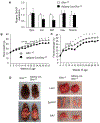GHS-R suppression in adipose tissues protects against obesity and insulin resistance by regulating adipose angiogenesis and fibrosis
- PMID: 33903722
- PMCID: PMC8238886
- DOI: 10.1038/s41366-021-00820-7
GHS-R suppression in adipose tissues protects against obesity and insulin resistance by regulating adipose angiogenesis and fibrosis
Abstract
Background/objectives: Ghrelin is an orexigenic hormone that increases food intake, adiposity, and insulin resistance through its receptor Growth Hormone Secretagogue Receptor (GHS-R). We previously showed that ghrelin/GHS-R signaling has important roles in regulation of energy homeostasis, and global deletion of GHS-R reduces obesity and improves insulin sensitivity by increasing thermogenesis. However, it is unknown whether GHS-R regulates thermogenic activation in adipose tissues directly.
Methods: We generated a novel adipose tissue-specific GHS-R deletion mouse model and characterized the mice under regular diet (RD) and high-fat diet (HFD) feeding. Body composition was measured by Echo MRI. Metabolic profiling was determined by indirect calorimetry. Response to environmental stress was assessed using a TH-8 temperature monitoring system. Insulin sensitivity was evaluated by glucose and insulin tolerance tests. Tissue histology was analyzed by hematoxylin/eosin and immunofluorescent staining. Expression of genes involved in thermogenesis, angiogenesis and fibrosis in adipose tissues were analyzed by real-time PCR.
Results: Under RD feeding, adipose tissue-specific GHS-R deletion had little or no impact on metabolic parameters. However, under HFD feeding, adipose tissue-specific GHS-R deletion attenuated diet-induced obesity and insulin resistance, showing elevated physical activity and heat production. In addition, adipose tissue-specific GHS-R deletion increased expression of master adipose transcription regulator of peroxisome proliferator-activated receptor (PPAR) γ1 and adipokines of adiponectin and fibroblast growth factor (FGF) 21; and differentially modulated angiogenesis and fibrosis evident in both gene expression and histological analysis.
Conclusions: These results show that GHS-R has cell-autonomous effects in adipocytes, and suppression of GHS-R in adipose tissues protects against diet-induced obesity and insulin resistance by modulating adipose angiogenesis and fibrosis. These findings suggest adipose GHS-R may constitute a novel therapeutic target for treatment of obesity and metabolic syndrome.
Conflict of interest statement
Figures






Similar articles
-
Ablation of ghrelin receptor reduces adiposity and improves insulin sensitivity during aging by regulating fat metabolism in white and brown adipose tissues.Aging Cell. 2011 Dec;10(6):996-1010. doi: 10.1111/j.1474-9726.2011.00740.x. Epub 2011 Oct 12. Aging Cell. 2011. PMID: 21895961 Free PMC article.
-
GHS-R in brown fat potentiates differential thermogenic responses under metabolic and thermal stresses.PLoS One. 2021 Apr 1;16(4):e0249420. doi: 10.1371/journal.pone.0249420. eCollection 2021. PLoS One. 2021. PMID: 33793646 Free PMC article.
-
Suppression of GHS-R in AgRP Neurons Mitigates Diet-Induced Obesity by Activating Thermogenesis.Int J Mol Sci. 2017 Apr 14;18(4):832. doi: 10.3390/ijms18040832. Int J Mol Sci. 2017. PMID: 28420089 Free PMC article.
-
p53 Functions in Adipose Tissue Metabolism and Homeostasis.Int J Mol Sci. 2018 Sep 4;19(9):2622. doi: 10.3390/ijms19092622. Int J Mol Sci. 2018. PMID: 30181511 Free PMC article. Review.
-
Ghrelin: much more than a hunger hormone.Curr Opin Clin Nutr Metab Care. 2013 Nov;16(6):619-24. doi: 10.1097/MCO.0b013e328365b9be. Curr Opin Clin Nutr Metab Care. 2013. PMID: 24100676 Free PMC article. Review.
Cited by
-
Regulation of adipose tissue lipolysis by ghrelin is impaired with high-fat diet feeding and is not restored with exercise.Adipocyte. 2021 Dec;10(1):338-349. doi: 10.1080/21623945.2021.1945787. Adipocyte. 2021. PMID: 34224298 Free PMC article.
-
Innate immunity in peripheral tissues is differentially impaired under normal and endotoxic conditions in aging.Front Immunol. 2024 Aug 16;15:1357444. doi: 10.3389/fimmu.2024.1357444. eCollection 2024. Front Immunol. 2024. PMID: 39221237 Free PMC article.
-
Novel Role of Ghrelin Receptor in Gut Dysbiosis and Experimental Colitis in Aging.Int J Mol Sci. 2022 Feb 17;23(4):2219. doi: 10.3390/ijms23042219. Int J Mol Sci. 2022. PMID: 35216335 Free PMC article.
-
Genetic or pharmacological GHSR blockade has sexually dimorphic effects in rodents on a high-fat diet.Commun Biol. 2024 May 25;7(1):632. doi: 10.1038/s42003-024-06303-5. Commun Biol. 2024. PMID: 38796563 Free PMC article.
-
Ablation of Ghrelin Receptor Mitigates the Metabolic Decline of Aging Skeletal Muscle.Genes (Basel). 2022 Jul 30;13(8):1368. doi: 10.3390/genes13081368. Genes (Basel). 2022. PMID: 36011279 Free PMC article.
References
-
- Kursawe R, Caprio S, Giannini C, Narayan D, Lin A, D'Adamo E, et al.: Decreased transcription of ChREBP-alpha/beta isoforms in abdominal subcutaneous adipose tissue of obese adolescents with prediabetes or early type 2 diabetes: associations with insulin resistance and hyperglycemia. Diabetes 2013, 62:837–844. - PMC - PubMed
-
- Kozak LP, Koza RA, Anunciado-Koza R: Brown fat thermogenesis and body weight regulation in mice: relevance to humans. Int J Obes (Lond) 2010, 34 Suppl 1:S23–27. - PubMed
Publication types
MeSH terms
Substances
Grants and funding
LinkOut - more resources
Full Text Sources
Other Literature Sources
Medical
Miscellaneous

